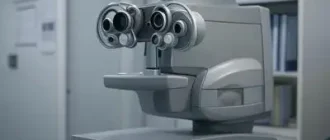Eye dilation allows optometrists to observe the entire retina and rear eye structures, detecting various ocular conditions in depth. However, for some individuals, the intrusive nature of the procedure or its mild side effects may seem worrisome. Thankfully, several alternatives to eye dilation exist — they can provide similar results, reducing or eliminating the need for the traditional dilation.
Optomap
The Optomap is a non-invasive, digital imaging technology that captures a wide-area view of the retina. Created by Optos, this device doesn’t require the administering of dilating drops, making it feasible for individuals apprehensive about the traditional dilation process. Instead, it harnesses low-level laser technology that allows swift, safe, and comfortable retina examinations.
Retinal Photography
Retinal photography, another alternative, enables detailed inspections of the eye’s interior. With the patient’s eye targeted with bright illumination, the device captures an image of the light reflected off the inner surfaces. It’s often used for patients who desire close monitoring of existing retinal abnormalities.
Optical Coherence Tomography (OCT)
Optical Coherence Tomography, or OCT, employs light waves to procure cross-sectional images of the retina. It efficiently maps and measures the layers, aiding in the early detection and diagnosis of major eye diseases like glaucoma, macular degeneration, or retinal detachment.
Conclusion
However, it is crucial to note that none of these alternatives replace a full dilation exam conducted by an optometrist. These technologies serve as complementary tools to the traditional eye dilation process, providing additional information and offering comfort for patients opposed to dilation.
So, individuals who wish to avoid dilation must consult with an eye care professional to discuss these alternatives and choose the most suitable method for their eye health.
| Alternatives to Eye Dilation | Pros | Cons |
|---|---|---|
| Optomap | Non-invasive, Safe, Quick | May miss small details |
| Retinal Photography | Detailed images of eye’s interior, Useful for monitoring retinal abnormalities | Bright light may cause discomfort |
| Optical Coherence Tomography (OCT) | Detailed mapping and measurements of retina, Useful for early diagnosis of major eye diseases | More expensive, Not suitable for all patients |





